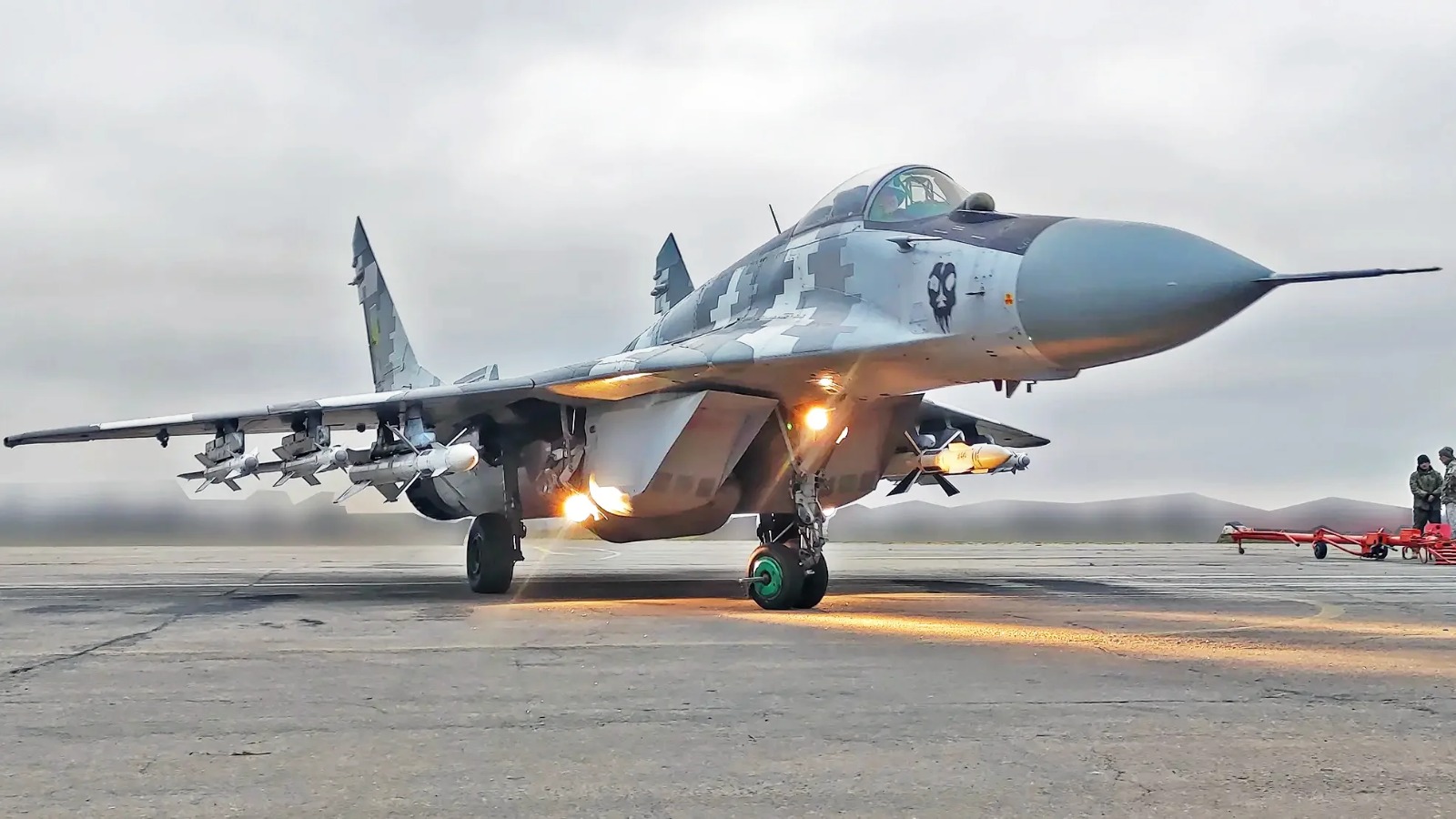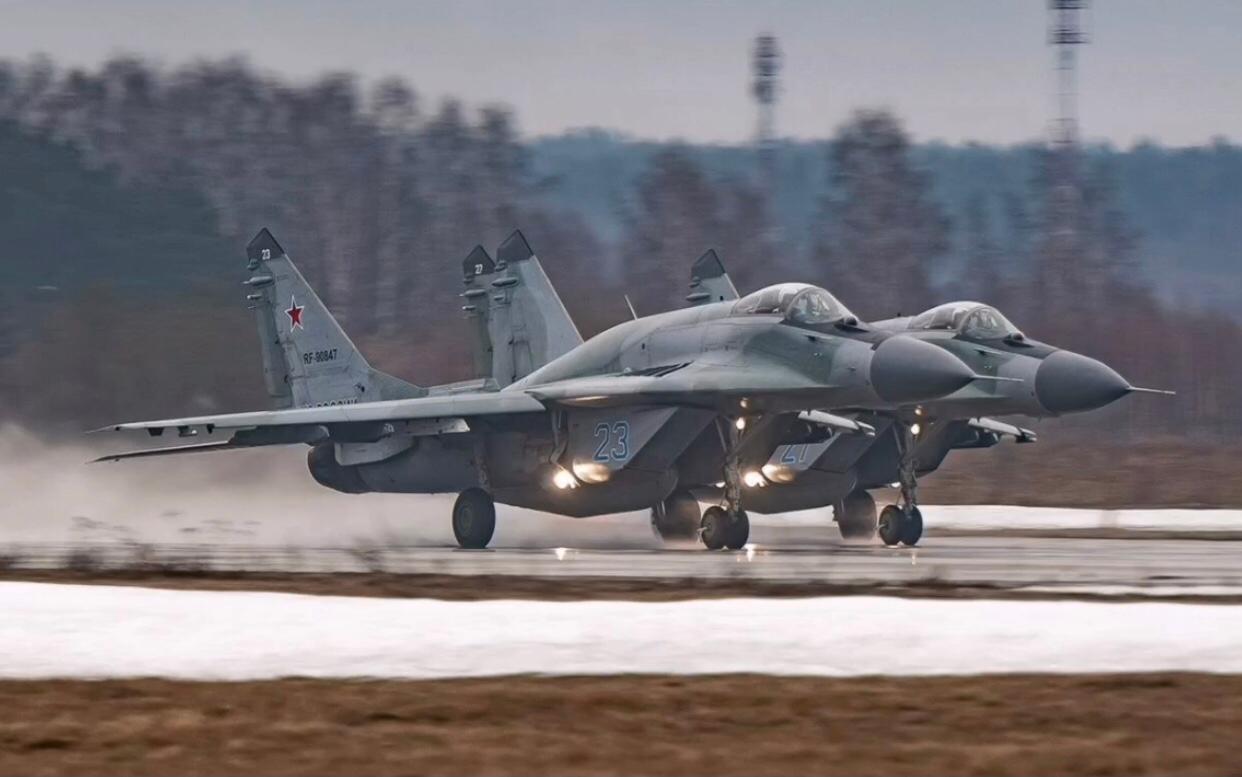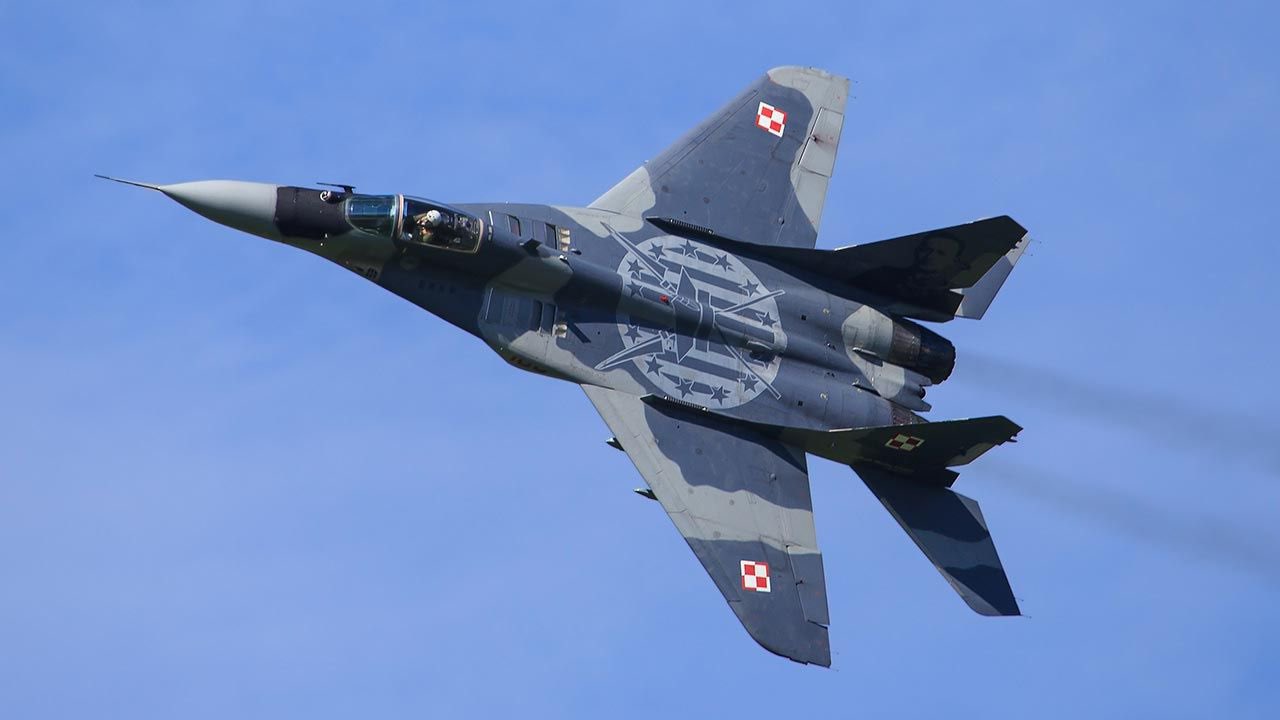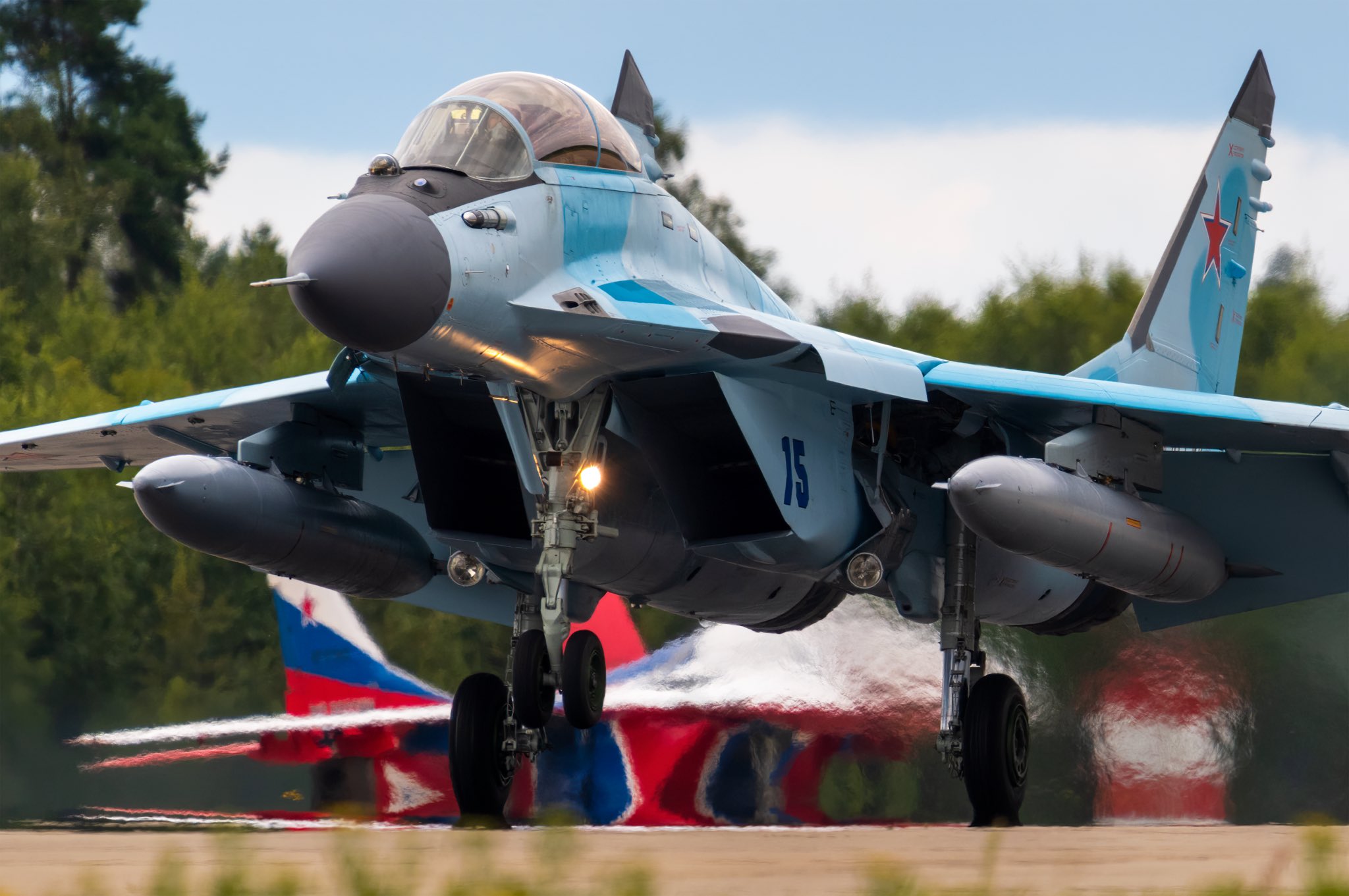The Soviet-era Mikoyan MiG-29 “Fulcrum,” an air superiority fighter, was a very popular aircraft. Over 1,600 were built and bought or operated by over 40 countries. Despite initially having conventional flying controls, it could outperform its contemporaries, the F-16 and Mirage-2000.
The aircraft entered service in 1983 and saw significant operational action. It continues to be in production.
Unfortunately, its more advanced and latest variant, the multi-role MiG 35 “Fulcrum-F,” which made its first flight in December 2016, has had no takers, and only 8 aircraft have been built to date.
The Mikoyan Design Bureau of 1939-vintage was a global household name for many decades after WW II. Its MiG-15s had seen great action in the Korean and Vietnam Wars, and over 13,000 were produced.
Its MiG 19s had sold in large numbers, with over 2,000 built by the Soviets and 4,000 variants by China. Subsequently, the MiG-23, 25, and 27 were great success. MiG-31 continues to be a formidable platform and is still being built.
But, with the success of the Sukhoi Su-27 basic aircraft and its variants, the Sukhoi Design Bureau started taking the lead. The end of the Cold War also saw further consolidation of the Russian aircraft industry, and in 2006, Mikoyan became a division of the United Aircraft Corporation in a merger with Ilyushin, Irkut, Sukhoi, Tupolev, and Yakovlev.
The capacity to push MiG-35 in global markets was reduced. MiG-35s capability advantage over upgraded variants of MiG-29s was very nominal. It is interesting to understand the dynamics.
Mikoyan MiG-29 ‘Fulcrum’
The MiG-29 is a twin-engine fighter aircraft designed as an air superiority fighter during the 1970s. Along with the larger Sukhoi Su-27, it was developed to counter the new US fighters, the McDonnell Douglas F-15 ‘Eagle’ and the General Dynamics F-16 Fighting Falcon.
The MiG-29 entered service with the Soviet Air Forces in 1983 and formally joined the Indian Air Force (IAF) in 1987. The aircraft was designed to have positive but close to neutral longitudinal stability, which allowed good maneuverability. The aircraft also had a high thrust/weight ratio, allowing high sustained rates of turn.
More recent variants, such as the MiG-29M, have multirole capabilities with a range of air-to-surface armaments and precision munitions. The marine variant, the Mikoyan MiG-29K, operates on aircraft carriers, including with the Indian Navy.
Later variants had improved engines, glass cockpits with HOTAS-compatible flight controls, modern radar, and infrared search and track (IRST) sensors, and increased internal fuel capacity. They were equipped for aerial refueling.
The Russian Aerospace Forces wanted to upgrade its existing fleet to the modernized MiG-29SMT configuration, but post-Soviet dissolution financial difficulties slowed the process. Currently, nearly 800 MiG-29 variants are still active in many air forces, making it the 5th most common active fighter.
MiG Aircraft Transitions
MiG-21s had given a tough fight to the F-4 Phantoms in Vietnam. Yet to take on advanced F-4 variants, the Soviets developed the MiG-23 swing-wing fighter with both strike and air defense variants.
Its very powerful engine gave it great acceleration, and with swept wings, it was difficult to catch in a chase. Later, the Soviets began working on the “Advanced Lightweight Tactical Fighter” called the MiG-29 to compete with the evolving American “Lightweight Fighter”, the F-16.
The MiG-29 directly replaced the MiG-23 in the frontal aviation role.
MiG-29 Variants & Upgrades
Interestingly, the MiG-29 has some broad aerodynamic similarities to the Sukhoi Su-27, but there are some stark differences, including wing mounting, tailfins, etc. The Su-27 was always designed with fly-by-wire and longitudinal instability for better maneuverability.
MiG-29 kept getting radar, avionics, and weapon upgrades. In the 1980s, the MiG-29S could carry the longer-range R-27E air-to-air missiles. It got a dorsal ‘hump’ in the upper fuselage to house a jamming system and some additional fuel capacity. The weapons load was increased to 4,000 kg with airframe strengthening.
The baseline MiG-29 radar was the Phazotron N019 Sapfir S-29 look-down/shoot-down coherent pulse-Doppler radar. Later, an improved Sapfir-23ML coupled with a new digital computer was introduced. The upgraded MiG-29M offers the N010 Zhuk-M, which has a planar array antenna rather than a dish and better processing.
India was the first international customer of the MiG-29 outside of the Warsaw Pact and ordered 44 aircraft initially. 36 more aircraft were ordered later. The Indian Navy acquired 45 MiG-29K, which entered service in 2010, for operations on INS Vikramaditya.
Starting in 2009, the IAF MiG-29s were upgraded through an initial deal with Russia. They got the R-77/RVV-AE air-to-air missile. The N019 radar was replaced by a Phazotron Zhuk-M radar. Air-to-air refueling was introduced.

Avionics and cockpit upgrades were also made. 11 BRD Air Force upgraded nearly 63 aircraft in India. In 2020, India ordered 21 refurbished MiG-29s at an affordable price from Russia.
The carrier-based MiG-29K was never produced in large numbers. It was operated only on the Indian Navy’s INS Vikramaditya and the Russian Navy’s Admiral Kuznetsov class aircraft carriers. The MiG-29K reportedly has radar-absorbing coatings to reduce its signature.
The Russian attempt to design and replace the MiG-29 with the MiG 1.44 failed in the 1990s, as it never crossed the demonstrator stage. Similarly, the plan to replace the Su-27 variants with the fifth-generation Su-57 ‘Felon’ also got considerably delayed. Experts are wondering if the smaller fifth-generation fighter Su-75 ‘Checkmate’ will one day replace the MiG-29.
The MiG-29 has two widely spaced Klimov RD-33 turbofan engines, with a maximum 81.3 kN thrust. While powerful, they were fuel guzzlers and left a significant smoke trail. The MiG 29 engine air intakes were a complex system, with auxiliary ones operating during takeoff, landing, and low-altitude flying, preventing the ingestion of ground debris. This was subsequently changed for the MiG-35 and made similar to the Su-27.
The MiG-29’s internal fuel capacity was rather low, limiting its range and endurance. Major modifications were needed to increase this in later models and the MiG-35. Also, an inflight refueling probe was added.
The MiG-29 has a single GSh-30-1 30 mm cannon in the port wing root. In later variants, its 150-round magazine was reduced to 100 rounds, limiting the total firing burst. Three pylons are provided under each wing (four in some later variants).
MiG-29M2 with two RD-133 3D thrust-vectoring engines was eventually used only in aerobatic demonstrations with the hope of exports.
German Air Force Assessment
East Germany had bought 24 MiG-29s. After reunification, the German Air Force’s MiG-29s carried out joint DACT exercises with US fighters.
The German pilots admitted that the Fulcrum was more maneuverable at slow speeds than all existing American fighters and its Vympel R-73 dogfight missile was superior to the base AIM-9 Sidewinder.
The German pilots felt that the American fighters had the advantage in avionics and in both night and bad weather combat conditions. The MiG-29 was good for point defense but not for fighter sweeps over hostile airspace.
In 1997, the United States purchased 21 Moldovan MiG-29 aircraft, 14 of which were MiG-29S models. These were used for combat evaluation by the USAF, the USN, and the USMC.
Russian MiG-29s In Recent Operations
In April 2008, a Russian MiG-29 reportedly shot down a Georgian Hermes 450 unmanned aerial vehicle using an R-73 heat-seeking missile. In July 2014, a Russian MiG-29 shot down a Ukrainian Su-25 using an R-27T missile.

In early September 2017, the Russian Aerospace Forces deployed some MiG-29SMT aircraft to Khmeimim Airbase in western Syria. The MiG-29SMT were involved in bombing missions and bomber escort duties. Wagner Group also operated Russian MiG-29s in Libya.
MiG-29s In Ukraine
During the initial days of the war in Donbas in April 2014, Ukraine deployed some MiG-29s to perform combat air patrols and show-of-force flights. At least three were shot down in action.
Ukraine domestically upgraded the MiG-29 to have multirole capability, known as the MiG-29MU2. The first upgraded MiG-29 was delivered to the Ukrainian Air Force in July 2020. On 29 May 2020, Ukrainian MiG-29s took part in the Bomber Task Force in Europe with American B-1B bombers for the first time in the Black Sea region.
During the 2022 Russian invasion of Ukraine, Su-27s and MiG-29s were used as air superiority fighters, but ten MiG-29s were reported lost on the ground and in the air.
MiG-29s were also used to shoot down Shahed-136 drones with its cannon, but at least two were lost after they injected the debris.
Ukraine reportedly modified its aircraft to carry the American-supplied AGM-88 HARM missiles. Americans denied it, saying that Soviet-era aircraft don’t have the computer architecture to accept NATO standard weapons.
Poland had acquired MiG-29s, which it later acquired from Germany. In March 2023, Poland began transferring the operational MiG-29s to Ukraine.

Operations On MiG-29 By Foreign Operators
IAF MiG-29s were used extensively during the 1999 Kargil War as fighter escorts. Yugoslav MiG-29s saw little combat during the breakup of Yugoslavia and were used primarily for ground attacks. Six MiG-29s were shot down during the NATO intervention in the Kosovo War.
Iraq used MiG-29s in Operation Desert Storm, but its military was later disbanded. In the 1999 Eritrean-Ethiopian War, a number of Eritrean MiG-29s were shot down by Ethiopian Su-27s piloted by Russian mercenaries. There were also reports of Eritrean MiG-29s shooting down Ethiopian MiG-21s and MiG-23s.
Bangladesh Air Force operates 8 MiG-29s. Yemen has significantly upgraded MiG-29s.
Mikoyan MiG-35
The Mikoyan MiG-35 is essentially an upgraded multirole variant of MiG-29, a further development of the MiG-29M/M2, claimed to be 4++ generation.
The aircraft was presented to international customers at the 2017 Moscow air show. It currently has a PESA radar, and an option for an AESA radar is available. The serial production aircraft does not have thrust vectoring control, as previously planned. The first two serial production aircraft entered service in 2019.
In the late 1980s, the MiG-35 was originally planned to be a single-engine combat aircraft for air-to-air and secondary air-to-ground roles, more like the Indian LCA envisaged at that time.
But Seeing India’s MMRCA competition unfold, Russia unveiled a model of MiG-29M that was given the temporary name “MiG-35” for marketing and export purposes at the 2007 Aero India air show in Bangalore. By 2013, the Russian Air and Space Forces wanted to order 37 aircraft. The figures later went up to 170.
Yet another “New MiG-35” variant with a Russian non-removable NPK-SPP OLS-K electro-optical targeting and surveillance system pod, mounted directly to the aircraft below the right (starboard) fuselage on the engine nacelle in front of the elevators, was announced. It was capable of detecting ground targets up to 20 km and sea targets up to 40 km. Serial production MiG-35s are now equipped with a PESA radar of the Zhuk family. Russia also offered the new Phazotron Zhuk-A/AE AESA radar for the export market.
In June 2019, Russian Aerospace Forces received the first two serially produced MiG-35s. These had revised tailfins, uprated Klimov RD-33MK engines with 9-ton thrust, and an active-array (AESA) radar capable of tracking up to 30 targets simultaneously.
The number of weapon stations has increased to 9 (similar to MiG-29M2). The MiG-35 was planned to launch the Kh-36 Grom-1 cruise missile, giving it a longer-range strike capability than the MiG-29.
In May 2021, MiG-35 received a preliminary certificate for limited series production even as it was undergoing state joint trials. It was claimed that the flight range had increased by 50 percent, and radar visibility had been reduced. The maximum payload was 6.5 tons.

The plans for a thrust vectoring variant of MiG-35 were canceled but could be introduced on customer request. A carrier-based version of the MiG-35 is reportedly also under development.
Reports in 2023 suggested that the aircraft had entered production and was being used operationally in the Russian invasion of Ukraine.
Why No Takers for MiG-35
Clearly, the Russians themselves were a little confused about the type of variant MiG-35 they would be. Finally, they settled for an upgraded version of the MiG-29. It is akin to the F-16 Block 70/72 being renamed F-21 that the US is offering to India. Most countries did not see any value addition to their inventories.
US Pushes “F-22, F-35 Fusion” To Indian Air Force Under Make In India; Lockheed Boss Meets PM Modi
Russia is currently at war in Ukraine. It is also under Western economic sanctions. Most of its aircraft factories are busy with war production requirements. Also, some of the electronic components going on board the aircraft were coming from some European countries, and this route has dried up. A modern fighter aircraft cannot be offered without AESA radar.
Russian aircraft exports have been slowing down recently. The financial state of the aircraft corporations is not as healthy as it should be, as exports have been shrinking. Their ability to market has withered.
Russian aircraft designers and engineers are still poorly paid and have low motivation. The smarter and better ones moved to the West in the late 1990s, and Russia’s global clout is also weakening. Meanwhile, the newer fifth-generation aircraft, the Su-57 and Su-75, are both from the Sukhoi stable. So, clearly, the MiG designs are getting left behind.
Egypt, which initially wanted to buy MiG-35 in 2014, finally chose to purchase 46 MiG-29M/M2 multi-role fighters instead. MiG-35 remains one of the competitors for India’s 114 new MRCA fighters, for which the RFP has still to be sent out. Russia negotiated with Bangladesh for the sale of MiG-35, but it could not be pursued due to a shortage of funds.
China has already mastered the making of many Su-27 variants and invested significantly in that basic design. They have bought 24 Su-35s to further copy and reverse-engineer them.
China never went the Mikoyan route after MiG-21. India has already upgraded its MiG-29s. It is also upgrading the Su-30 MKI fleet. India’s significant concentration now is on indigenous LCA Mk2, which will be of a similar or better class than MiG-35. If both China and India don’t show interest in a product, the countries of the Global South become cautious and wait for a lead.
The MiG designers have to think ahead and come out with a futuristic aircraft concept and design, lest the great legacy of Artem Mikoyan and Mikhail Gurevich be consigned to history.
- Air Marshal Anil Chopra (Retired) is an Indian Air Force veteran fighter test pilot and former Director-General of the Center for Air Power Studies in New Delhi. He has been decorated with gallantry and distinguished service medals while serving in the IAF for 40 years.
- He tweets @Chopsyturvey
- Follow EurAsian Times on Google News




